by Valerie Mendez Stansly | Aug 23, 2024
 Every fall, as the North Florida Fair rolls into Tallahassee, 4-H members eagerly anticipate 4-H Day, a special day filled with excitement beyond the usual fair food and rides. This annual event offers 4-H participants a chance to dive into a range of contests and activities, with one of the highlights being the Wildlife Ecology contest. During this competition, young people get the opportunity to test their knowledge and skills by identifying various forest trees and wildlife, making it a fantastic blend of fun and learning.
Every fall, as the North Florida Fair rolls into Tallahassee, 4-H members eagerly anticipate 4-H Day, a special day filled with excitement beyond the usual fair food and rides. This annual event offers 4-H participants a chance to dive into a range of contests and activities, with one of the highlights being the Wildlife Ecology contest. During this competition, young people get the opportunity to test their knowledge and skills by identifying various forest trees and wildlife, making it a fantastic blend of fun and learning.
The Contest
The 4-H Wildlife Judging Contest is a showcase of both individual and team talents. All youth ages 8-18 can participate as individual competitors. Participants from the same county can also be organized into teams of 3 or 4, and compete at Junior, Intermediate, and Senior levels based on age. At the end of the contest, the scores from the top three team members are combined to determine the team’s overall performance.
The contest is divided into various stations, each focusing on different aspects of wildlife and forest ecology. Three main topics covered during the fall contest are:
- Trees
- Mammals
- Birds, Reptiles, and Amphibians
Beyond the Contest
The 4-H Wildlife Judging Contest is much more than a competitive event; it’s a platform for essential life skill development. Preparation for and participation in the contest teach youth valuable lessons beyond academic knowledge of Florida’s ecology:
- Critical Thinking: Evaluating plants and wildlife involves using what youth know to make smart decisions. They have to consider various details, like the characteristics of different species and their role in the environment in order to properly identify the plant or animal species. This hands-on approach helps youth develop better problem-solving skills and feel more confident in their decision-making.
- Teamwork and Leadership: The contest encourages students to work together, which helps them learn how to communicate and support each other effectively. They also get a chance to take on leadership roles, guiding their team and making sure younger members understand the subject matter during preparation meetings. These experiences helps youth build important skills for working well with others in school and in their future careers.
- Dedication and Perseverance: Preparing for the contest takes a lot of hard work and commitment, as youth need to study and practice regularly. This process teaches them the value of persistence and dedication, which are important for achieving success in any area of life. The skills they develop through this effort can help them tackle challenges and stay focused on their goals.
Starting a Wildlife Ecology Club
If the opportunities offered by the 4-H Wildlife Judging Contest has inspired you, starting a Wildlife Ecology Club at your school or community center is a great way to engage more youth in environmental education. These clubs are wonderful way of integrating various age groups and skill levels, allowing members to work both independently and collaboratively. Inviting special speakers such as extension agents, foresters, and rangers can introduce youth to meaningful careers in forestry and wildlife conservation. In addition to club meetings, monthly hikes can provide hands-on experience, allowing kids to explore the outdoors while refining their identification skills.
Your local county 4-H agent and staff are the greatest resource on how you could get started in your area. Many counties in Florida already boast 4-H community clubs dedicated to wildlife and forest ecology that you can volunteer or meet to shadow before starting your own club. In addition, the Florida 4-H Forest Ecology page offers a wealth of information regarding the annual statewide and national Forest Ecology Contest that is held each spring.
Conclusion
The 4-H Wildlife Judging Contest at the North Florida Fair exemplifies the intersection of competition and education, offering a dynamic platform for youth to deepen their understanding of Florida’s forests and wildlife. Beyond the competition, the skills and experiences gained through participation are invaluable, preparing young individuals for future challenges and opportunities. Whether through participating or starting a new club, engaging with Florida’s wildlife and ecology fosters a lifelong appreciation for the natural world and equips youth with essential life skills.
by Heather Kent | Apr 16, 2024
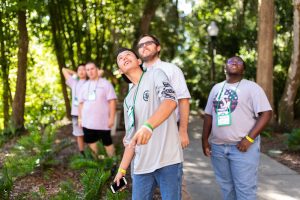 As the days grow longer and the weather warms up (but isn’t too hot), it’s the perfect time to take your 4-H club activities outdoors! Outdoor activities offer unique opportunities for hands-on learning, team building, and exploration of the natural world. Whether you’re in a rural setting or an urban environment, there are plenty of fun and engaging outdoor activities to enjoy with your 4-H group or as a family. This article shares five ways you can shake things up by taking it outside!
As the days grow longer and the weather warms up (but isn’t too hot), it’s the perfect time to take your 4-H club activities outdoors! Outdoor activities offer unique opportunities for hands-on learning, team building, and exploration of the natural world. Whether you’re in a rural setting or an urban environment, there are plenty of fun and engaging outdoor activities to enjoy with your 4-H group or as a family. This article shares five ways you can shake things up by taking it outside!
Nature Scavenger Hunt: Embark on a nature scavenger hunt to discover the wonders of the great outdoors! Create a list of items for participants to find, such as leaves of different shapes and sizes, animal tracks, bird feathers, or specific types of flowers. Divide the group into teams and set them loose to explore the surrounding area. Encourage participants to use their observation skills and work together to check off items on their list. The team that finds the most items within a designated time wins a prize!
- There is a native plant scavenger hunt as part of the Florida 4-H Bluebird project on page 9 of the Leader’s Guide.
- To make this even more engaging with youth, you can use iNaturalist. It is a free app from National Geographic that uses crowdsourcing to identify plants. You can create your scavenger hunt for your club in the app, and then families or teams of youth use their phone to take a picture, document, and identify plants or animals.
- If youth enjoy this type of activity, you might want to consider the Florida Friendly Landscaping Project or the Florida Youth Naturalist Project. Both projects guide youth through learning about Florida’s native plants and environments.
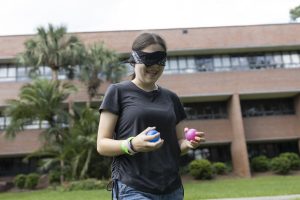 Outdoor Games Day: Organize a fun-filled outdoor games day for your 4-H club members to enjoy friendly competition and physical activity. Set up stations for classic games like sack races, tug-of-war, relay races, and frisbee throwing. You can also introduce lesser-known sports or activities such as disc golf, ultimate frisbee, or orienteering. Tailor the games to accommodate different skill levels and abilities, and encourage teamwork, sportsmanship, and fair play among participants. Don’t forget to provide plenty of water, sunscreen, and snacks to keep everyone energized throughout the day!
Outdoor Games Day: Organize a fun-filled outdoor games day for your 4-H club members to enjoy friendly competition and physical activity. Set up stations for classic games like sack races, tug-of-war, relay races, and frisbee throwing. You can also introduce lesser-known sports or activities such as disc golf, ultimate frisbee, or orienteering. Tailor the games to accommodate different skill levels and abilities, and encourage teamwork, sportsmanship, and fair play among participants. Don’t forget to provide plenty of water, sunscreen, and snacks to keep everyone energized throughout the day!
 Wildlife Watching: Take a walk on the wild side and explore the fascinating world of local wildlife! Visit nearby parks, nature reserves, or wildlife sanctuaries with your 4-H club and embark on a wildlife-watching adventure. Bring along binoculars, field guides, and notebooks to help identify and record sightings of birds, insects, mammals, reptiles, and amphibians. Encourage participants to observe animal behavior, habitat preferences, and adaptations to their environment.
Wildlife Watching: Take a walk on the wild side and explore the fascinating world of local wildlife! Visit nearby parks, nature reserves, or wildlife sanctuaries with your 4-H club and embark on a wildlife-watching adventure. Bring along binoculars, field guides, and notebooks to help identify and record sightings of birds, insects, mammals, reptiles, and amphibians. Encourage participants to observe animal behavior, habitat preferences, and adaptations to their environment.
- Consider inviting a local naturalist or wildlife expert to join you on your excursion and share their knowledge and expertise with the group.
- Visit a state park to look for signs of wildlife. You can request a letter from your Local UF IFAS Extension Office to waive the state park entry fee.
- Clover by 4-H offers several easy activities to support projects that are grab-and-go. Wildlife Signs is an activity that is appropriate for a variety of ages. This activity helps youth make observations about the wildlife around them, and can be a great introduction to the 4-H Wildlife project! To access the materials, you need to create a free account.
Fostering Further Engagement
Florida 4-H supports several project areas that foster a love of the outdoors. If you know a young person with a spark for the outdoors, encourage them to explore a project related to Wildlife, Forestry, Shooting Sports, or Sportsfishing. We also have a Forest Ecology Contest and a Wildlife Ecology Contest.
With a little creativity and enthusiasm, the possibilities for outdoor activities with your 4-H club are endless! Whether you’re exploring the wonders of nature, , engaging in friendly competition, or observing wildlife in its natural habitat, outdoor activities offer valuable opportunities for learning, growth, and connection. So, grab your sunscreen, put on your hiking boots, and get ready to make lasting memories with your 4-H club members and families in the great outdoors!
You
Write a blog article about 5 activities to teach 4-H youth about gardening
by Valerie Mendez Stansly | Mar 28, 2024
As we continue with part two of our series ‘Planning a Safe and Engaging Paddling Adventure for Youth,’ our goal is to highlight the key elements that make these excursions both memorable and educational. You will be introduced to the essentials of group dynamics, communication strategies, and incorporating educational components to your trip. Whether you’re planning a day trip or a multi-day camp, the information in this blog will help you navigate the challenges and delights of introducing young paddlers to the wonders of the great outdoors.
Paddling is a Group Activity
A successful paddling trip depends greatly on strong group dynamics and clear communication. Prior to getting on the water, it’s essential to conduct a thorough on-land training session that covers the basics of paddling, maintaining balance, and methods for recovering from a capsize. Turning these drills into interactive and enjoyable activities can greatly alleviate any nervousness and boost the confidence of your youth participants. For those organizing multi-day camps, scheduling this training a day in advance can be particularly beneficial—the more familiar youth become with these practices, the better.
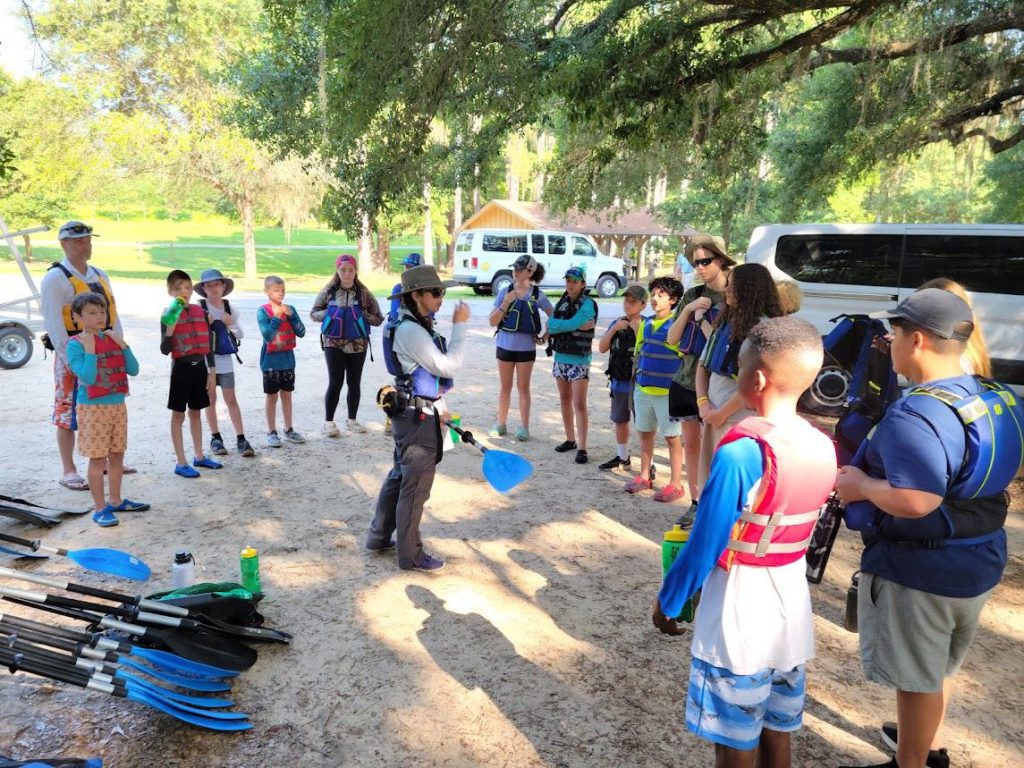
A successful paddling trip fosters solid group dynamics, clear communication, and teachers essential on-land training that covers paddling fundamentals, balance maintenance, and capsize recovery techniques.
Before setting out, it’s important that designated adult volunteers take on the specific roles, such as the lead and sweep, to maintain order and ensure the group’s safety throughout the adventure. The lead is responsible for navigating the route, monitoring for hazards, being mindful of other waterway users, and setting a pace that accommodates the entire group. The sweep boat, positioned at the end of the group, ensures that no one falls behind. This position requires experience with rescue situations, the capability to offer aid during capsizes or emergencies, and typically includes the responsibility of carrying a first aid kit along with having certifications in first aid, and CPR.
Effective and clear communication is essential when on the water. All paddlers should stay within earshot of each other to facilitate this. However, if distance makes verbal communication challenging, hand, paddle, and whistle signals become crucial tools for conveying messages. For instance, holding a paddle horizontally above your head signals others to stop paddling. Raising your arms vertically signifies an all-clear or prompts others to proceed. Waving your paddle overhead indicates a need for assistance in emergencies. To direct paddlers, use your paddle to point in the intended direction of travel, avoiding using it to point out hazards.
Whistle signals also play a key role in communication:
- One whistle blast calls for attention, urging the group to stop and wait for further instructions.
- Two blasts instruct paddlers to stop and remain in their current location.
- Three blasts signal an emergency, indicating that help is needed.
By creating clear communication among experienced adults, the trip not only becomes safer but also serves as an opportunity to demonstrate responsibility and leadership to youth on the trip. This structure provides a secure environment where youth can focus on refining their paddling skills and fully engage in the educational aspects of the activity. Modeling teamwork within the adults fosters a sense of unity throughout the team, enabling everyone to navigate challenges more effectively.
In case of a Capsize
When someone capsizes, it’s essential to remember your rescue priorities. The safety of people is always the most important. First, make sure everyone is safe. Then, collect boats and paddles. After securing the larger items, you can retrieve smaller gear like water bottles and dry bags.
If you’re the rescuer, it’s crucial to stay calm and control your boat to avoid becoming a casualty yourself. Ask for help if needed, giving clear instructions to the victim or other group members. If you’re witnessing a capsize, sometimes the best action is to stay clear unless the rescuer calls for assistance. If asked to help, follow their instructions while keeping yourself and your boat under control.
As a potential rescuer, remember the sequence talk – reach – throw – paddle – go.
- Talk: Start by getting the attention of the capsized paddler using your voice, whistle, or another sound device. Often, simply talking them through staying calm and performing a self-rescue is enough.
- Reach: If more than verbal guidance is needed, use the reach method. Extend your paddle or arm to help. Guide them to the front of your kayak for safety, avoiding having them hold onto the side, which could destabilize your kayak.
- Throw: When the capsized paddler is too far for a reach, throw them a rope or a life float they can grab onto.
- Paddle: If neither talking, reaching, nor throwing works, paddle close enough to them so they can be safely pulled to safety using the reach or throw method.
- Go: As a last resort, you may need to get into the water to assist, which involves significant risk. Ensure bystanders are calling for help while you swim to the capsized paddler’s aid.
This approach ensures everyone knows their role in a capsize situation, prioritizing safety and effective rescue techniques.
Outdoor Education and Stewardship
Enhance your paddling journey by turning it into a comprehensive educational experience, focusing on the local ecosystem and conservation initiatives. By immersing participants in the surrounding natural environment, you deepen their connection and commitment to environmental stewardship.
Teaching and practicing Leave No Trace principles is key to fostering respect for our natural surroundings. Paddling leaders play a crucial role in emphasizing the importance of minimizing our environmental impact, showing consideration for wildlife, and preserving the natural beauty of our waterways. Instilling these values in young paddlers helps them understand the critical role they play in conservation efforts and encourages them to engage in responsible outdoor behaviors well into adulthood.
Reflection
Incorporating a debrief, or post-trip reflection session, into your paddling adventure is an excellent way to incorporate principles of experiential learning, which values learning through action and reflection. After your trip, taking time for a debrief enables participants to express their thoughts on the activity, confront challenges encountered, and share new insights. Purposeful reflection is essential to the experiential learning process, helping learners to internalize their experiences and apply their insights in future contexts.
Debriefing among adults is also important. Scenarios encountered during the trip may highlight potential opportunities where additional training from certified instructors to improve paddling skills and safety knowledge is needed.
Conclusion
Embarking on a paddling adventure with youth offers more than just a day on the water; it’s an opportunity to foster teamwork, respect for nature, and a commitment to environmental stewardship through experiential learning. By incorporating safety, education, and reflection, we not only ensure a memorable and enriching experience but also instill important values and skills that youth will carry with them long after the trip ends.
Resources:
Want to learn more? Check out Paddle TV on YouTube which has made great videos in partnership with the American Canoe Association (ACA) by following the link: https://americancanoe.org/education/youth-paddling-development/educational-videos/
Consider using the Paddle Safe Paddle Smart (PS2) curriculum that has been created by ACA when implementing a paddling component during day camps or workshops.
Paddling Trip Checklist for Leaders
This checklist serves as a foundational tool for leaders to ensure that every aspect of the paddling trip is accounted for, from safety to environmental education. By following this guide and utilizing the checklist, leaders can provide a safe, enjoyable, and enriching paddling experience that youth participants will remember for years to come.
by Valerie Mendez Stansly | Mar 21, 2024
Setting off on a paddling adventure with youth, whether it involves canoeing, kayaking, or stand-up paddleboarding (SUP), offers a wonderful opportunity for them to get active, connect with the outdoors, and learn the value of teamwork. These activities can leave a lasting impression on the young people involved, fostering feelings of accomplishment, resilience, and fellowship. However, the responsibility on the adults leading these trips is significant. Ensuring a safe, educational, and enjoyable experience requires meticulous planning, a focus on safety, and a commitment to engaging each participant. Through this blog series, you will be provided with the insights and tools necessary to organize a successful paddling event for youth.
Securing Kayaks
Safety is the foundation of any successful paddling adventure, especially when involving young people. A critical, yet often overlooked, aspect of this safety is the secure transportation of your kayaks. Begin by firmly attaching your kayaks to your trailer using suitable straps. Before hitting the road, double-check that the straps are tightly fastened, the ends are securely tied off, and the kayak doesn’t move when you gently rock it.
When loading a kayak, always position the straps in advance. It’s a team effort to safely lift the kayak by its bow (front) and stern (back) handles—remembering to bend at the knees to protect your back. Once the kayak is evenly placed on the trailer’s crossbars, secure it properly by using the appropriate ties. Although ratcheting straps are commonly used, they can potentially damage your kayak due to excessive pressure. As an alternative, the use of buckle bumper straps offers a safe and user-friendly solution for both novices and experienced paddlers alike. Ensuring your kayaks are safely secured not only protects your equipment but also ensures the safety of everyone on the road.
Planning is Essential – Crafting a Float Plan
The backbone of a smooth paddling adventure is a detailed float plan. This document should outline your route, expected weather conditions, participant list with emergency contacts, and a timeline of the trip. Utilizing resources such as the Coast Guard Float Plan Central website ensures you don’t miss any critical planning steps. Your float plan should include not only the basics but also specific details such as the equipment each person will bring, health forms, expected departure and return times, access points, and the driving route. It’s also vital to assess and document the day’s weather, tides, water flow, and temperature, alongside local regulations, necessary permits, and the nearest emergency services and outfitters.
In addition to creating a comprehensive float plan, it’s essential to pack necessary items like water, snacks, sunscreen, and first-aid supplies, while encouraging lightweight packing to minimize the physical load on paddlers. Ensure that agents and other adults in charge involved are well-informed about the float plan, current and forecasted weather conditions, and the personal skills and comfort levels within the group.
Remember, the float plan is not just a list; it’s a snapshot of your group’s capabilities, equipment, and safety resources. Items not directly related to trip planning and participant safety should be recorded separately. Always leave the float plan with someone on shore who is familiar with the trip details, participants, and local area. This person’s responsibility is to alert local authorities should the group not return as scheduled. Typically, float plans are best entrusted to an agent and/or county extension director.
When you are out on the water, pay close attention to changing weather conditions. If the weather gets challenging, ensure your group stays together and maintains steady communication. In the case of unexpected thunder, lightning, heavy rain, or strong wind, find a protected area on land for the group to escape the elements. If the group gets off the water, be sure that boats or boards are far away from the water’s edge. Make sure to take all paddles and any food, water, and personal gear are with youth.
Choosing the Right Gear
Personal gear and preparedness are crucial for the success of your paddling trip. When choosing a paddling outfit, prioritize versatility, durability, and protection against cold, and wet conditions. Here are some key guidelines:
- Personal Flotation Device (PFD): Always wear a PFD while on the water. Ensure it fits snugly without riding up over your face or head. If adjustments are needed, do so safely onshore.
- Temperature Considerations: Youth and adults should dress for potential immersion. Hypothermia, a dangerous drop in body temperature, can occur in water temperatures as “warm” as 70 degrees Fahrenheit, according to U.S. Coast Guard. Conversely, hyperthermia results from overheating, often due to hot, humid conditions. Dressing in layers will help adjust for body temperature changes during the trip.
- Sun Protection: Applying sunscreen is critical for preventing sunburn and overheating, even on cloudy days. Due to the reflective nature of water, apply sunscreen often. Mineral sunscreen, with zinc oxide or titanium dioxide, forms a barrier against UV rays with a reduce risk of irritation or allergic reaction and is favored by many paddlers.
- Avoid cotton and restrictive clothing: Steer clear of cotton clothing such as jeans and hoodies, which retain water when wet. Instead choose garments made from quick-drying, moisture-wicking synthetics, or wool, which provide insulation even when wet. Fortunately, outfitting yourself appropriately doesn’t have to break the bank—many of these items can be readily found at affordable prices in secondhand stores like Goodwill.
By following safety guidelines and preparing with the right gear, paddlers can enjoy a safe and comfortable experience on the water, ready to face varying temperatures and conditions with confidence. In the next blog, we will discuss group management and safety considerations to take while on the water.
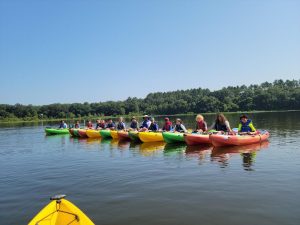
Introducing youth to the joys of paddling can create unforgettable memories that last a lifetime. At the same time, it’s crucial that we, as adults, prioritize their safety above all.
Resources:
Want to learn more? Check out Paddle TV on YouTube which has made great videos in partnership with the American Canoe Association (ACA) by following this link: https://americancanoe.org/education/youth-paddling-development/educational-videos/
Consider using the Paddle Safe Paddle Smart (PS2) curriculum that has been created by ACA when implementing a paddling component during day camps or workshops.
by lauenc | Feb 5, 2024
Hunting, when approached responsibly, can be a rewarding and educational experience for young individuals. As a 4-H agent dedicated to fostering a love for the outdoors, I recognize the importance of instilling a strong foundation of ethics and safety when introducing youth to the world of hunting. To ensure a positive and educational introduction to this amazing tradition, several key considerations should be considered.
- Safety Training and Ethical Hunting Practices:
The Florida Fish and Wildlife Conservation Commission (FWC) offers comprehensive safety resources, emphasizing the importance of proper firearm handling, wildlife identification, and safe hunting practices. Educating young hunters about the critical role of safety protocols ensures a secure and enjoyable experience in the field. There are a variety of hunter safety courses available. Visit the Which Hunter Safety Course Is Right For You? | FWC (myfwc.com) webpage to find out what course to see what may work best for your family. If you have completed an online course and have a certificate, you can participate in the upcoming Field Day on November 18, 2023 at West Pittman Baptist Church in Holmes County. Visit the Hunter Safety Registration (site.com) webpage to register or find other courses in your area on a different date.
- First Shot Fundamentals:
Holmes County 4-H has been awarded several grants from the The National Rifle Association (NRA) Foundation. Our Holmes County 4-H Shooting Sports Program includes archery, rifle, and shotgun disciplines. Youth members learn “first shot fundamentals” that will translate to important life skills as they may choose to ultimately participate in hunting opportunities. Emphasizing the values of fair chase, respect for wildlife, and the importance of humane and responsible harvesting helps instill a deep appreciation for the natural world and ecosystem.
- Conservation Education:
Collaborating with 4-H programs that incorporate conservation education can help young hunters understand the vital role they play in wildlife conservation and habitat preservation. Teaching the principles of sustainable hunting and the importance of maintaining ecological balance contributes to the development of environmentally conscious and responsible hunters. This also includes ongoing education and research related to Chronic Wasting Disease (CWD) in Holmes County and the surrounding region to learn what we, as hunters, can do to help.
- Mentorship Programs:
The Florida Fish & Wildlife Conservation Commission often organizes mentorship programs that pair experienced hunters with newcomers. These programs, align with 4-H’s emphasis on positive youth development and foster a supportive learning environment. Mentors follow the guidance outlined in mentorship materials to provide hands-on training, impart valuable skills, and promote the development of strong ethical values in young hunters. Visit the Mentored Hunts Registration (site.com) webpage to find upcoming opportunities across the state of Florida.
- Legal Compliance and Regulations:
The Florida Fish and Wildlife Conservation Commission (FWC) provides up-to-date information on hunting regulations, licensing requirements, and seasonal restrictions. Educating youth about these regulations instills a sense of responsibility and legal compliance, contributing to the cultivation of law-abiding and conscientious hunters.
By integrating these considerations into the process of introducing youth to hunting, we can ensure that they develop not only a passion for the sport, but also a respect for wildlife and the natural world. Together, we can foster the next generation of responsible and ethical hunters who prioritize safety, conservation, and ethical hunting practices in their outdoor adventures. For more information about how your youth can get involved with Holmes County 4-H, visit the Holmes County 4-H (holmescounty4h.com) webpage.
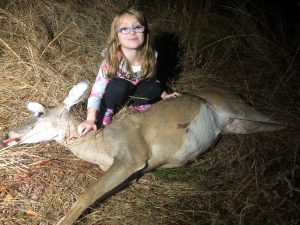
Miah, daughter of the Holmes 4-H Agent, enjoys the opportunity to harvest her first deer at age 6.

Holmes County 4-H Agent, Chris Lauen, introduces his children to a Holmes County whitetail buck.
by Heather Kent | Sep 7, 2023
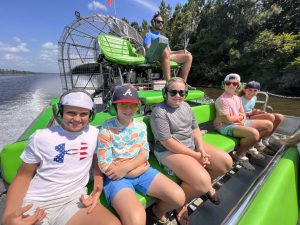
4-H youth explored different Florida habitats to learn about species.
Thanks to Fish Florida, 4-H youth across the panhandle are exploring their sparks related to fishing and Florida’s natural resources. Fish Florida supports organizations like 4-H that teach people, especially children, about Florida’s fish and aquatic habitats through donations of fishing equipment, grants, and scholarships. Their mission is to promote public awareness of and encourage the protection of marine fisheries and coastal habitats through non-formal education. Because their mission aligns so well with the mission of Florida 4-H, this partnership has been very successful.
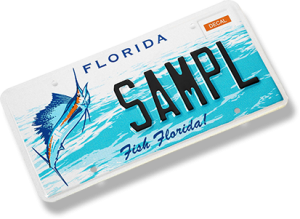
Fish Florida grants are supported through the sales of specialty tags.
Six Florida panhandle counties received equipment and funds to support 4-H fishing clubs and day camps, reaching 43 adult volunteers and nearly 200 youth. Through these programs, 4-H faculty, staff, and volunteers taught young people about different types of fishing equipment, how to rig a rod and reel, how to cast, how to tie different types of fishing knots, how to identify Florida fresh and saltwater fish, how to fish ethically (following Florida Fish and Wildlife regulations), water and boating safety, and more.
One 4-H youth shared, “I always enjoyed going fishing before, but now I understand what types of equipment and bait I need to use to catch the type of fish I like to catch. This program has also helped me understand why we have certain regulations to protect Florida habitats.”
Youth participating in the 4-H sportfishing program had the opportunity to visit a variety of Florida habitats to learn about different fish, including salt water, brackish water, and freshwater. They also met with professionals in the fishing and wildlife industries to learn about potential careers related to the fishing industry, as well as conserving Florida’s unique natural habitats. This program would not have been possible without the support from Fish Florida, which is funded through the sales of the Florida Sailfish specialty license plate.
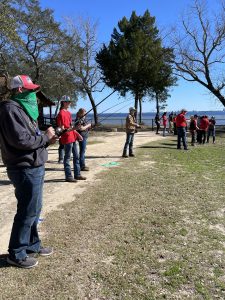
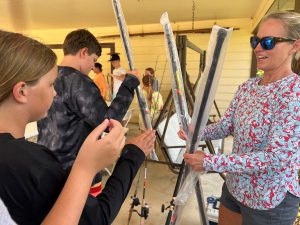

4-H programs in Florida’s panhandle provide several ways for youth to explore their interests related to fishing and the outdoors:
- Clubs- Youth can participate in 4-H clubs that are focused on fishing, natural resources, and the outdoors (shooting sports, ATV safety, camping). Clubs are the foundation of 4-H. A 4-H club is a group of five or more youngsters guided by one or more adults. A club can be any size–from a small group of kids from the same neighborhood to a large group of youth from within the county. Clubs typically meet at least once a month to participate in activities to learn more about a topic. These activities might include games, field trips, guest speakers, and contests. To learn more about what a 4-H club is, visit our website.
- Day Camps– Many counties offer day camps focused on fishing and the outdoors. These are typically held during the summer months, or on non-school days. Day camps are a great way for youth who are new to 4-H to get a feel for what 4-H offers.
- Residential Camps– 4-H Camp Timpoochee in Niceville, FL offers residential camps to help youth explore Florida’s environments. This camp is the oldest 4-H camp in Florida and is located on the Choctwhathatchee Bay.
- School Programs– Counties offer a variety of programs through the schools to support non-formal learning. One of these programs is the Florida Youth Naturalists. The Florida Youth Naturalists program guides youth through an exploration of Florida’s uplands, wetlands, and coastal ecosystems and was inspired by the Master Naturalist Program, which is targeted toward adults.
- Contests– Youth can also participate in contests related to the fields of conservation and ecology such as the 4-H Wildlife Ecology Contest at the North Florida Fair. Activities and study guides to prepare for 4-H Wildlife Ecology can be found online. The deadline to register for the 4-H Wildlife Ecology Contest is October 13. Another contest related to outdoor education is the 4-H Forest Ecology Contest. A clinic to prepare for the State 4-H Forest Ecology Contest will be held on October 14th, and the deadline to register for the clinic is September 23 in 4HOnline.
Check out our 4-H Sportfishing Project Page to learn more about our programs related to fishing. To learn more about Fish Florida, or how you can support them through the Sailfish License Plate program, visit their website. To learn more about opportunities for you to share your passion for fishing with the next generation, or to get your child involved, contact your local UF IFAS County Extension Office.
 Every fall, as the North Florida Fair rolls into Tallahassee, 4-H members eagerly anticipate 4-H Day, a special day filled with excitement beyond the usual fair food and rides. This annual event offers 4-H participants a chance to dive into a range of contests and activities, with one of the highlights being the Wildlife Ecology contest. During this competition, young people get the opportunity to test their knowledge and skills by identifying various forest trees and wildlife, making it a fantastic blend of fun and learning.
Every fall, as the North Florida Fair rolls into Tallahassee, 4-H members eagerly anticipate 4-H Day, a special day filled with excitement beyond the usual fair food and rides. This annual event offers 4-H participants a chance to dive into a range of contests and activities, with one of the highlights being the Wildlife Ecology contest. During this competition, young people get the opportunity to test their knowledge and skills by identifying various forest trees and wildlife, making it a fantastic blend of fun and learning.










